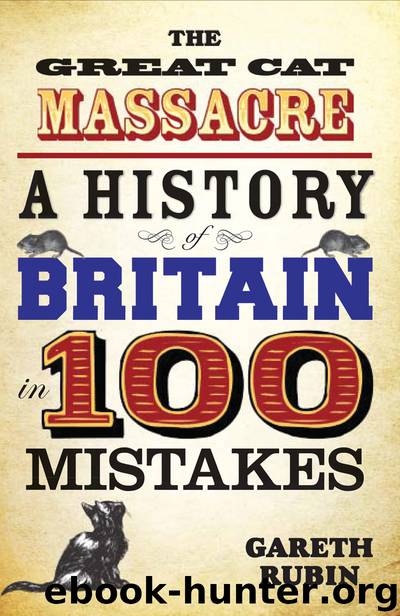The Great Cat Massacre - a History of Britain in 100 Mistakes by Gareth Rubin

Author:Gareth Rubin [Rubin, Gareth]
Language: eng
Format: mobi, azw3
Tags: Europe, General, Great Britain, Humor, History
ISBN: 9781784180669
Google: UZ5eAwAAQBAJ
Publisher: John Blake Publishing
Published: 2014-05-07T18:30:00+00:00
The main lesson from the history of cultural creation is that those who most want to contribute to it are often the last people you want doing so. In the fields of literature, architecture and study of history, it’s usually someone so fixated on leaving a part of himself to posterity who has his back turned to the realities of the here and now. So desperate to be judged well by future generations, he often feels he can get away with leaving the current one to hang or believes in flattering liars who should be turned out and pursued with a pitchfork and flaming torches.
A FAKE THAT STUCK – NAMING THE HILLS, 1747
Not exactly a mistake, but a hoax that continues to this day and will go on fooling people for a long time. The Pennine Hills aren’t really the Pennines – or at least you might as well make up your own name for them, really.
The story begins in 1746 when Charles Bertram, a 23-year-old English tutor at the Royal Marine Academy in Copenhagen, began to correspond with a noted British historian, William Stukeley.
Bertram claimed to have found an ancient manuscript composed by a medieval English monk by the name of Richard of Westminster. It included a travelling itinerary by a Roman general complete with the lost Roman names for British places and a map. The document apparently detailed the Roman occupation of Britain.
His letter read that he had ‘at present in my Possession, a copy of an old Manuscript Fragment (and am in hopes of getting the original) called Ricardi Monachi Westmonasteriensis comentariolum Geographicum de situ Britanniae & Stationum quas Romani ipsi in ea Insula aedificauerunt. It seems to me to have been part of a greater Treatise compiled out of Beda, Orosius, Pliny, &c. & some Authors quite unknown; it is pity it is so tenuous, consisting only of four sheets & an half in Quarto, the half of Parchment on which is depicted in colours the Islands of Britain, but in a manner peculiar to this Author.’
Stukeley was excited – at the time, many historians had been discussing how Britain had been divided during the Roman era – and asked to see the document. Bertram sent him what he said was a copy he had made of the original, which he did not want to send. He later sent Stukeley a fragment of parchment, which was confirmed by an expert as being four centuries old.
Stukeley went about researching this mysterious mediaeval monk and found, by chance, a likely candidate with a similar name and background, adding to his belief that the document was genuine. He announced to the world that an invaluable record of Roman Britain had been found, declaring: ‘We learn from the present work, now happily preserved, the completest account of the Roman state of Brittain, and of the most antient inhabitants thereof; and the geography thereof admirably depicted in a most excellent map.’
Bertram published the document and map as De Situ Britanniae (Description of Britain), and the pair were generally taken to be true by British scholars.
Download
The Great Cat Massacre - a History of Britain in 100 Mistakes by Gareth Rubin.azw3
This site does not store any files on its server. We only index and link to content provided by other sites. Please contact the content providers to delete copyright contents if any and email us, we'll remove relevant links or contents immediately.
| Belgium | France |
| Germany | Great Britain |
| Greenland | Italy |
| Netherlands | Romania |
| Scandinavia |
Room 212 by Kate Stewart(5040)
The Crown by Robert Lacey(4727)
Endurance: Shackleton's Incredible Voyage by Alfred Lansing(4683)
The Iron Duke by The Iron Duke(4293)
The Rape of Nanking by Iris Chang(4139)
Joan of Arc by Mary Gordon(4016)
Killing England by Bill O'Reilly(3953)
Say Nothing by Patrick Radden Keefe(3903)
I'll Give You the Sun by Jandy Nelson(3359)
Shadow of Night by Deborah Harkness(3306)
Hitler's Monsters by Eric Kurlander(3269)
Mary, Queen of Scots, and the Murder of Lord Darnley by Alison Weir(3152)
Blood and Sand by Alex Von Tunzelmann(3140)
Darkest Hour by Anthony McCarten(3072)
Eleanor & Park by Rainbow Rowell(3063)
Margaret Thatcher: The Autobiography by Thatcher Margaret(3029)
Red Famine: Stalin's War on Ukraine by Anne Applebaum(2874)
Book of Life by Deborah Harkness(2869)
The One Memory of Flora Banks by Emily Barr(2803)
